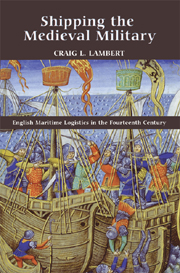Book contents
- Frontmatter
- Contents
- List of Tables
- Acknowledgments
- Abbreviations
- Introduction
- 1 Raising a Fleet
- 2 The Supply of Armies and Garrisons by Sea, 1320–1360
- 3 The Transportation of English Armies to France, 1324–1360
- 4 Maritime Resources and the King's War
- Conclusion
- Appendix 1 Ports that Supplied Ships to the Fleets
- Appendix 2 Reconstructing the Merchant Fleet: A Methodology
- Bibliography
- Index
- Warfare in History
Introduction
Published online by Cambridge University Press: 12 September 2012
- Frontmatter
- Contents
- List of Tables
- Acknowledgments
- Abbreviations
- Introduction
- 1 Raising a Fleet
- 2 The Supply of Armies and Garrisons by Sea, 1320–1360
- 3 The Transportation of English Armies to France, 1324–1360
- 4 Maritime Resources and the King's War
- Conclusion
- Appendix 1 Ports that Supplied Ships to the Fleets
- Appendix 2 Reconstructing the Merchant Fleet: A Methodology
- Bibliography
- Index
- Warfare in History
Summary
In a very short time the wind had filled the sail and blown us out of sight of the land of our birth. And I tell you now that anyone who sets out on such a dangerous course is foolhardy. For at night you fall asleep without knowing whether you will find yourself the next morning at the bottom of the sea.
Let me tell you of the great peril that befell a Catholic king in the presence of the Old Pilgrim. This king was crossing the sea between Cyprus and Syria in company with other ships and galleys. The weather was fine. Suddenly a squall sprang up which did not last long but can be extremely dangerous if it strikes a ship with all sail spread. An old sailor said that it would be wise to lower the sail. But the captain paid no heed. Hit by another squall in such wise and with such violence that the ship went over on her beams-ends and was half under water. The great sail and topmast were in the sea.
The two passages above suggest that maritime travel during the middle ages was a dangerous affair, and indeed it could be, as Edward III's return journey from his campaign in Brittany in 1343 amply shows; sea journeys could be perilous. Nevertheless, by the time Edward III crossed the Channel on 28 October 1359 English forces had already achieved many successful sea journeys to launch campaigns in France.
- Type
- Chapter
- Information
- Shipping the Medieval MilitaryEnglish Maritime Logistics in the Fourteenth Century, pp. 1 - 10Publisher: Boydell & BrewerPrint publication year: 2011



